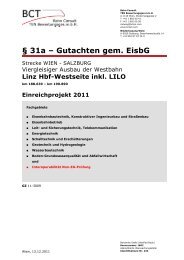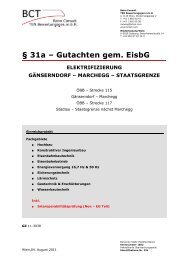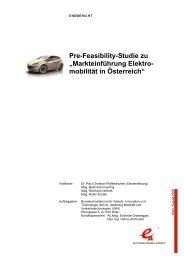Schriftenreihe .;technologiekompetenz Verkehr in
Schriftenreihe .;technologiekompetenz Verkehr in
Schriftenreihe .;technologiekompetenz Verkehr in
Create successful ePaper yourself
Turn your PDF publications into a flip-book with our unique Google optimized e-Paper software.
AUTOMOBILE PLATFORM<br />
EVs currently available on the market are mostly built based on<br />
an adaptation of a conventional automobile platform. This,<br />
however, does not allow EVs to develop their full potential. Due<br />
to greater simplicity and - for <strong>in</strong>stance - fewer drivetra<strong>in</strong><br />
components, electric concepts have the potential to significantly<br />
improve the economy of space and also offer more freedom<br />
when it comes to design <strong>in</strong> general.<br />
Nowadays, OEMs commonly use shared automotive platforms;<br />
they are often even co-jo<strong>in</strong>tly developed and utilised. Platform<br />
strategies and modularity concepts are targeted at the possibility<br />
of broad usage and easy adaptation of variants. The goal is to<br />
m<strong>in</strong>imise the amount of variant-specific parts among a vehicle<br />
family and consequently to achieve overall cost reduction,<br />
especially through lower purchas<strong>in</strong>g costs. Of course, the <strong>in</strong>itial<br />
efforts for develop<strong>in</strong>g such an automobile platform are<br />
tremendously high <strong>in</strong> terms of costs, manpower and time. Thus,<br />
platform developments can only be cost-effective when<br />
reach<strong>in</strong>g if mass production is achieved.<br />
These large <strong>in</strong>vestments that have been made for conventional<br />
automotive platforms and production facilities on the one hand<br />
and those <strong>in</strong>vestments that have to be made for new electric<br />
vehicle platforms on the other hand lead to hesitant changes <strong>in</strong><br />
the automotive <strong>in</strong>dustry. However the decision to develop new<br />
approaches <strong>in</strong> design and development of electric vehicle offers<br />
high opportunities to establish new products and brands on the<br />
market and ga<strong>in</strong> competitiveness for this high potential<br />
segment.<br />
Another important aspect for future electric vehicle platform<br />
development is the formation of strategic alliances between the<br />
automotive and the electronics <strong>in</strong>dustry. S<strong>in</strong>ce the competence<br />
of the OEM <strong>in</strong>dustry has been focus<strong>in</strong>g on mechanical<br />
components like ICEs and conventional drivetra<strong>in</strong>s, electric<br />
traction and related technologies have not been a primary focus.<br />
The formation and establishment of strategic alliances can<br />
enable accelerated state-of-the-art development of electric<br />
traction systems and components <strong>in</strong> accordance with<br />
automotive standards.<br />
In addition efforts have to be taken to simplify and coord<strong>in</strong>ate<br />
technical regulations worldwide and develop new standards and<br />
harmonise homologation procedures. This is of high importance<br />
for a fast market <strong>in</strong>troduction of relevant electric vehicle<br />
components, like switches, connectors, etc., as well as to<br />
support the establishment of vehicle platforms and by that mass<br />
production. Future <strong>in</strong>creases of consumer-side demand for EVs<br />
as well as political <strong>in</strong>centives will contribute to steer these<br />
developments <strong>in</strong> the automotive <strong>in</strong>dustry.<br />
CHARGING INFRASTRUCTURE<br />
ELECTRIC VEHICLES<br />
A precondition for successful market <strong>in</strong>troduction of electric<br />
vehicles is the existence of an adequate charg<strong>in</strong>g <strong>in</strong>frastructure.<br />
The costs of develop<strong>in</strong>g a viable <strong>in</strong>frastructure, and if required<br />
the supply logistics, determ<strong>in</strong>e whether a new technology<br />
becomes established. A key advantage for the development of<br />
an electric charg<strong>in</strong>g <strong>in</strong>frastructure is the fact, that <strong>in</strong> developed<br />
countries practically every home has an electricity supply. If<br />
certa<strong>in</strong> framework conditions are met, such as the wattage<br />
supply necessary to charge an electric vehicle with<strong>in</strong> an<br />
acceptable period of time, a comprehensive <strong>in</strong>frastructure can<br />
be built up relatively easily and quickly. At the same time, the<br />
load on the electricity networks must also be taken <strong>in</strong>to<br />
consideration. This shows that a variety of concepts must be<br />
pursued to develop an adequate charg<strong>in</strong>g <strong>in</strong>frastructure, but also<br />
that a dense network of charg<strong>in</strong>g stations can be implemented<br />
relatively cost-effectively.<br />
Charg<strong>in</strong>g an EV is usually a matter of hours („overnight<br />
charg<strong>in</strong>g”) <strong>in</strong> order to guarantee proper lifetime and safe<br />
operation of the batteries. To overcome this issue where<br />
„charg<strong>in</strong>g along the way“ is not a solution, some vehicle<br />
manufacturers concentrate on the implementation of a fuel cell,<br />
which allows refill<strong>in</strong>g with<strong>in</strong> m<strong>in</strong>utes and offers separate battery<br />
recharge as an option.<br />
21

















